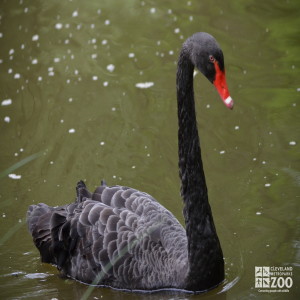 The black swan is native to Australia and is found in the wetlands of southern Australia. The black swan lives in lakes, rivers, and swampland. They are most likely found at sites with aquatic vegetation but can survive in flooded fields when food is scarce. The black swan is the largest of the waterfowl. Full grown, the black swan measures between 110 to 142 centimeters (43 to 56 inches) in length and weighs between 3.7 to 9.0 kilograms (8.2 to 19.8 lbs). The wingspan is between 1.6 and 2 meters (5.2 to 6.6 ft).
The black swan is native to Australia and is found in the wetlands of southern Australia. The black swan lives in lakes, rivers, and swampland. They are most likely found at sites with aquatic vegetation but can survive in flooded fields when food is scarce. The black swan is the largest of the waterfowl. Full grown, the black swan measures between 110 to 142 centimeters (43 to 56 inches) in length and weighs between 3.7 to 9.0 kilograms (8.2 to 19.8 lbs). The wingspan is between 1.6 and 2 meters (5.2 to 6.6 ft).
Location: Animals Formerly at Zoo
Share:
Range
Black swans are native to Australia and New Zealand. They are found mostly in the southern portion of the Australian continent.
Habitat
Black swans are found in lakes, rivers, and swampland which can be fresh, salt, or brackish water. They prefer living in habitats that contain abundant aquatic vegetation.
Conservation Status
Least Concern
Primary Threats
Gestation
The breeding season is from February to September (rainy season) with the female laying between 4 to 6 eggs which incubate for 35 to 48 days. The young swans can start to fly at about 6 months.
Litter
4 to 6 cygnets (baby swans)
Behavior
While the black swans may be found as a single, they are often seen in loose flocks made up of several hundreds of individuals. When on the ground, the group is known as a "bank" but in flight, they are called a "wedge". The birds are mostly monogamous-pairing for life. At the death of a mate, the surviving swan usually does not try to find a new partner. The black swans are nomadic when food is scarce, otherwise tend to remain sedentary. They tend to feed at dusk and move at night always calling as they travel. When molting, the black swan will lose all of its flight feathers and is unable to fly for a month, settling on large open waters.
Reproduction
The black swans are monogamous (mate for life). The black swans are territorial and will usually mate away from the group. The unique courting behavior is the "Triumph Ceremony". It is used to strengthen the pair-bonds between mates, between parents and cygnets, and for threatening behavior. The male swan approaches the female with wings and chin up, calling repeatedly. The female then returns the same call. Then they dip their heads alternating with erect postures. Then the birds call with their necks outstretched and the bills pointed upward; then they hold their necks at a 45 degree angle and point their bills downward and at a right angle, while swimming in a circle. The eggs are deposited on a nest of sticks, dead leaves, and debris that is a floating mound on top of the water. Both parents help incubate the eggs. Sexual maturity occurs between 18 to 36 months.
Wild Diet
The black swan is a herbivore, lives on aquatic and marshland algae and other plants.
Zoo Diet

